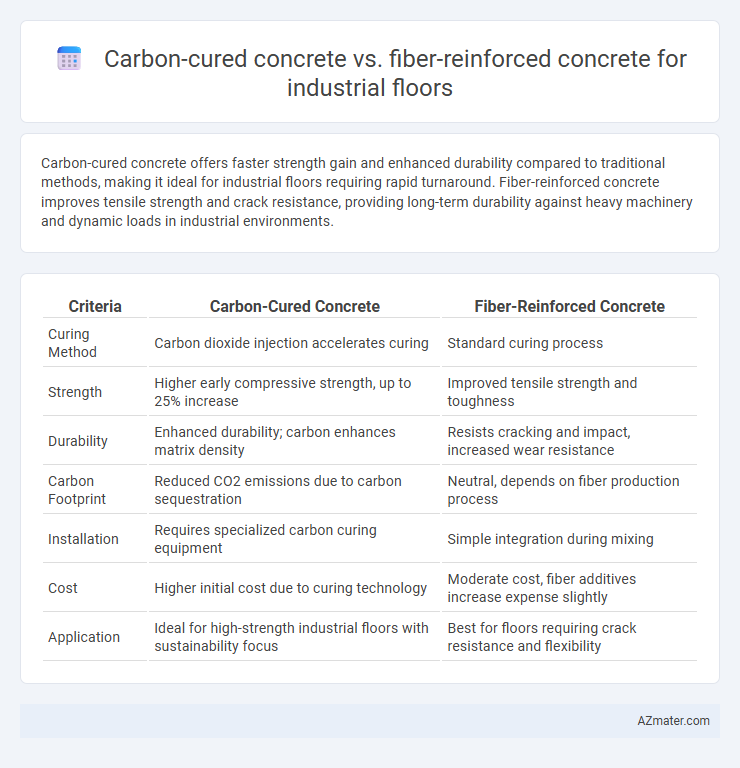Carbon-cured concrete offers faster strength gain and enhanced durability compared to traditional methods, making it ideal for industrial floors requiring rapid turnaround. Fiber-reinforced concrete improves tensile strength and crack resistance, providing long-term durability against heavy machinery and dynamic loads in industrial environments.
Table of Comparison
| Criteria | Carbon-Cured Concrete | Fiber-Reinforced Concrete |
|---|---|---|
| Curing Method | Carbon dioxide injection accelerates curing | Standard curing process |
| Strength | Higher early compressive strength, up to 25% increase | Improved tensile strength and toughness |
| Durability | Enhanced durability; carbon enhances matrix density | Resists cracking and impact, increased wear resistance |
| Carbon Footprint | Reduced CO2 emissions due to carbon sequestration | Neutral, depends on fiber production process |
| Installation | Requires specialized carbon curing equipment | Simple integration during mixing |
| Cost | Higher initial cost due to curing technology | Moderate cost, fiber additives increase expense slightly |
| Application | Ideal for high-strength industrial floors with sustainability focus | Best for floors requiring crack resistance and flexibility |
Introduction to Industrial Floor Concrete Solutions
Carbon-cured concrete enhances industrial floor durability by accelerating strength gain through CO2 curing, resulting in lower permeability and improved environmental sustainability. Fiber-reinforced concrete incorporates synthetic or steel fibers to increase tensile strength, reduce cracking, and improve impact resistance for heavy-duty industrial floors. Both solutions address different performance needs: carbon curing targets sustainability and early strength, while fiber reinforcement boosts mechanical resilience and longevity.
Overview of Carbon-Cured Concrete
Carbon-cured concrete utilizes carbon dioxide in the curing process to enhance strength, durability, and reduce curing time, making it highly suitable for industrial floors with heavy load demands. This method improves the concrete's densification, leading to enhanced resistance against chemical corrosion and abrasion compared to traditional curing techniques. By incorporating carbon capture technology, carbon-cured concrete also contributes to sustainability efforts through lower carbon emissions during production.
Overview of Fiber-Reinforced Concrete
Fiber-reinforced concrete (FRC) enhances traditional concrete by incorporating fibrous materials such as steel, glass, or synthetic fibers, improving tensile strength and crack resistance, making it highly suitable for industrial floor applications. This type of concrete offers superior durability under heavy mechanical stress and reduces the need for steel reinforcement, leading to faster installation and lower maintenance costs. FRC's improved impact resistance and reduced shrinkage cracking contribute to longer service life and enhanced performance in industrial environments compared to carbon-cured concrete.
Strength and Durability Comparison
Carbon-cured concrete exhibits enhanced strength through accelerated carbonation, resulting in a denser microstructure that increases compressive strength by up to 20% compared to traditional curing methods. Fiber-reinforced concrete incorporates synthetic or steel fibers to improve tensile strength and crack resistance, providing superior durability in high-impact and heavy-load industrial floors. While carbon curing optimizes surface hardness and chemical resistance, fiber reinforcement delivers better overall toughness, making the choice dependent on specific industrial floor performance requirements.
Crack Resistance and Structural Performance
Carbon-cured concrete enhances crack resistance by promoting rapid hydration and denser microstructure, leading to improved durability and reduced shrinkage cracks in industrial floors. Fiber-reinforced concrete integrates synthetic or steel fibers that arrest crack propagation and enhance structural performance by distributing tensile stresses more evenly. Both materials improve load-bearing capacity, but carbon-cured concrete offers faster strength gain, while fiber reinforcement provides superior toughness and impact resistance for heavy-duty industrial applications.
Installation Process and Time Efficiency
Carbon-cured concrete utilizes a curing process involving carbon dioxide injection, accelerating hardening and reducing installation time by up to 30% compared to traditional methods. Fiber-reinforced concrete requires precise mixing and placement to evenly distribute fibers, which can extend installation duration but enhances long-term durability and reduces maintenance. For industrial floors, carbon curing offers faster turnaround, while fiber reinforcement provides structural benefits that might justify longer installation.
Environmental Impact and Sustainability
Carbon-cured concrete reduces carbon emissions by absorbing CO2 during the curing process, enhancing environmental sustainability through lower carbon footprints compared to traditional methods. Fiber-reinforced concrete improves durability and reduces maintenance needs, indirectly contributing to sustainability by extending the lifespan of industrial floors and minimizing resource consumption. Both materials promote sustainability, but carbon-cured concrete offers a more direct carbon reduction advantage in industrial floor applications.
Cost Analysis: Initial and Lifecycle Expenses
Carbon-cured concrete for industrial floors generally incurs higher initial costs due to specialized curing equipment and CO2 injection processes, while fiber-reinforced concrete often has a lower upfront expense with the addition of fibers during mixing. Lifecycle expenses favor carbon-cured concrete as it offers enhanced durability and reduced maintenance through improved strength and reduced cracking, leading to lower repair costs over time. Fiber-reinforced concrete may have comparatively higher long-term maintenance needs despite its cost-effectiveness at installation.
Maintenance Requirements and Longevity
Carbon-cured concrete offers enhanced durability by reducing microcracks through carbon dioxide curing, which significantly lowers maintenance needs by minimizing surface wear and chemical degradation. Fiber-reinforced concrete boosts tensile strength and crack resistance with embedded fibers, improving the floor's lifespan and decreasing repair frequency in industrial environments. Both materials provide longevity benefits, but carbon-cured concrete excels in chemical resistance while fiber-reinforced concrete better manages structural stress and impact resistance.
Recommended Applications for Industrial Floors
Carbon-cured concrete offers enhanced durability and lower carbon footprint, making it ideal for industrial floors exposed to heavy machinery and chemical resistance requirements. Fiber-reinforced concrete provides superior tensile strength and crack resistance, which is recommended for high-traffic areas subject to dynamic loads and impact. Both materials improve longevity, but fiber-reinforced concrete excels in surface toughness, while carbon-cured concrete benefits sustainability and durability.

Infographic: Carbon-cured concrete vs Fiber-reinforced concrete for Industrial floor
 azmater.com
azmater.com